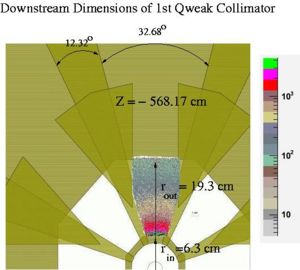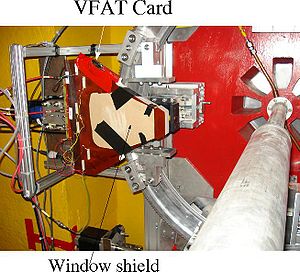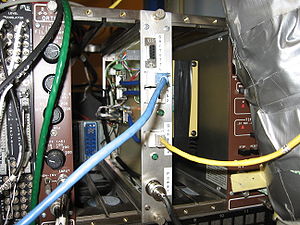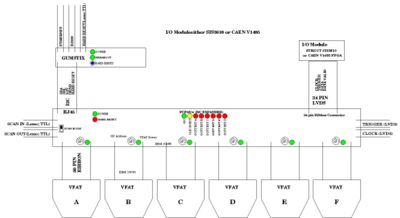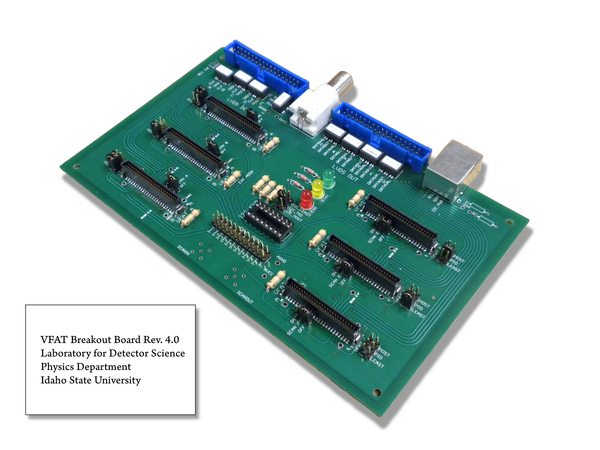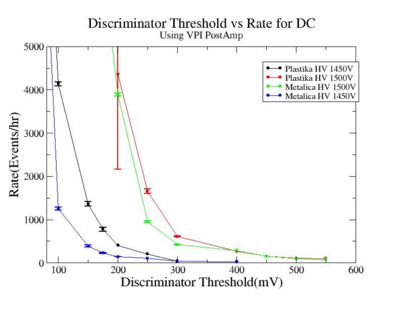Difference between revisions of "ForestNSFInterimReport 8-31-10"
| Line 53: | Line 53: | ||
==== VFAT board communication==== | ==== VFAT board communication==== | ||
| − | The figure below shows a NIM model build by ISU student Tamar Didberidze. The module is used to power the VFAT cards and house the microcontroller computer for I2C communication. | + | The figure below shows a NIM model build by ISU student Tamar Didberidze. The module is used to power the VFAT cards and house the microcontroller computer for I2C communication. The blue line connects the breakout box to the I2C controller and the yellow line is a serial interface for debugging the microcontroller. |
[[File:GumstixI2CNIMModule.jpg|300px]] | [[File:GumstixI2CNIMModule.jpg|300px]] | ||
Revision as of 23:59, 26 August 2010
ARRA reports
7/14/10
ARRA funding has supported the activities of 5 personnel working to fulfill the research objectives outlined in NSF award #PHY-0855661. The objectives of the last quarter, as described in the above proposal, were to complete installation of the Qweak detectors in Hall C at Jefferson Lab and begin the construction of the R1 chambers for Hall B. The Qweak detectors for Jlab's Hall C have been delivered and one of the detectors is currently operating in the Hall. The mounting system for the detectors was the responsibility of another institution and has faced some challenges delaying it's completion. T. Didberidze and principal investigator, T. Forest, have made two trips to JLab to complete the installation and plan at least one final trip at the end of July. The construction of the R1 drift chambers for Hall B has been delayed by Hall B management for about 8 months. B. Starks has been designing several clean room options to facilitate the construction of the R1 chambers during the past quarter and will finalize the design by the end of July. C. Taylor used his calibration work on g13 to calibrate the start counter for the FROST experiment at Jlab as a collaborative service task. D. Martinez is has completed calibrating the time-of-flight system for the g13 experiment and is now using that calibration to search for mesons to analyze for his thesis. W. Parsons defended his thesis on the Qweak readout system and is currently completing thesis revisions. J. Salamanca has graduated since the last quarter and taken a position at another institution.
1/14/10
ARRA funding has supported the activities of 6 personnel working to fulfill the research objectives outlined in NSF award #PHY-0855661. The objectives of the last quarter, as described in the proposal, were to complete testing of the Qweak region 1 tracking system and begin installing a clean room. T. Didberidze has completed testing the Qweak region 1 detector and has shipped one of the two detectors to JLab. B. Starks has received two air shower enclosures for the clean room and has installed a temperature monitoring system. W. Parsons has completed a software library which will be used in a readout system for the Qweak detector. J. Salamanca has graduated with a Ph. D. in physics and will be starting an academic position in Colombia. D. Martinez is calibrating a time-of-flight system for the g13 experiment in JLab's hall B. C. Taylor is calibrating the Large Angle Calorimeter for the g13 experiment in JLab's Hall B.
Participants
Tony Forest Principal Investigator Yes Phil Cole Principal Investigator No Dan Dale Principal Investigator No Tamar Didberidze Graduate student Yes Warren Parsons Graduate student No Berkley Starks Graduate student No Danny Martinez Graduate student No Julian Salamanca Graduate student No
Activities and Findings
This section will serve as your report to your program officer of your project's activities and findings. Please describe what you have done and what you have learned, broken down into four categories:
What have been your major research and education activities (experiments, observations, simulations,presentations, etc.)
The construction of the Region 1 tracking system for the Qweak experiment has been the main research focus of the support from this proposal. The Qweak experiment is scheduled to measure the parity violating elastic scattering of polarized electrons from protons at Jefferson Lab. The measurement will be used to extract the weak mixing angle and thereby test the standard model. The PI for this award is responsible for the design and construction of the Region 1 detector system. Other activities also undertaken include the testing of prototype drift chambers for the Hall-B 12 GeV upgrade and an analysis of experimental data which will lead towards the extraction of nucleon polarized structure functions. The progress of these endeavors is described below.
Qweak Region 1 Tracking System Detector Construction
The testing and installation of the Region 1 tracking system for the Qweak experiment at Jefferson Lab has been the main research activity supported by this grant. The Qweak Region 1 tracking system is one of three tracking systems designed to measure the profile of elastically scattered electrons as well as background contributions to the parity violating signal. The Region 1 tracking system is located behind the first collimator at a distance of about 550 cm from the main torus magnet ( 200 cm from the target). The collimator divides the acceptance into 8 regions, octants, and reduces the azimuthal acceptance by almost 30 percent. Figure 1a shows the elastic scattering profile overlayed on top of one of the octants. Figure 1b shows the detector mounted on the R1 rotator in preparation for a few tests. One VFAT card is mounted to the top of the detector so the impact of the high dose can be tested before installing all of the readout cards. The Region 1 tracking system will measure the electron scattering angle at only 2 of the octants at a time and will rotate in to perform measurements in the remaining octants.
Qweak readout electronics
The front end readout electronics for Qweak's region 1 tracking system will need to withstand the high radiation environment as well as have a fast throughput. One detector readout option being pursed is the VFAT digitization board developed at CERN for the TOTEM experiment. It was designed to be used for either silicon or GEM based detectors. The board can sample it's 128 input channels at 40 MHz and store up to 128 triggered events. The VFAT board has been designed to withstand up to 100 Mrad of radiation which is more than sufficient for Qweak. The VFAT card digitizes the analog output of the GEM detector to indicate the presence of a hit on one of the charge collector's copper strips. The PI has been using his start up funds to develop the infrastructure needed to deploy this front end electronics for the Qweak's region 1 tracking system. This infrastructure is described below.
The front end electronics to readout a detector contains three basic elements. The VFAT readout board will convert the analog charge observed on a charge collector strip to a digital signal which identifies the presence of a hit on the strip. A Gumstick controller is a small unix computer used to program the VFAT card and set parameters like the amplifier gain, the threshold, and check for failed flip/flops. A VME I/O board will receive the LVDS digital signals from the VFAT board and store them for readout by a single board computer located in the VME crate. For the past year, Brian Oborn has been working on the Gumstick controller to communicate with a VFAT board. Undergraduate student, Jordan Keough, is spending the summer designing a signal switchyard to establish lines of communication between the Gumstick computer, the VFAT board, and the VME I/O module.
VFAT board communication
The figure below shows a NIM model build by ISU student Tamar Didberidze. The module is used to power the VFAT cards and house the microcontroller computer for I2C communication. The blue line connects the breakout box to the I2C controller and the yellow line is a serial interface for debugging the microcontroller.
Readout switchyard
The lines of communication between the VFAT readout board, the Gumstick controller, and the VME FPGA I/O module are managed by a signal switchyard being designed at ISU. Brian Oborn, a technician from the IAC, is mentoring Jordan Keough's design of the signal switchyard board. Jordan is a physics undergraduate. The switchyard will divert signals between the three detector readout elements to their appropriate destination. I2C signals will travel between the Gum stick control computer to the VFAT readout card according to address switches on the switchyard board. The switchyard board will also be used to input clock signals for sampling the detector as well as a Flip Flop scan signal to check for radiation damage to the board. The switchyard will send LVDS signals containing the Detector data from the VFAT readout board to the VME FPGA I/O module.
Physics Analysis
While the construction and testing of ionization chambers for Qweak is a valuable graduate student hardware experience, the graduate student supported by this grant will need to write a thesis on a research physics topic. Due to the time constraints involved, Tamar Didberidze, has been doing her physics research on data that has already been taken. She has decided to work towards measuring the ratio of polarized to unpolarized down quark distribution in the nucleon. The PI's previous work at JLAB involved collecting polarized electron scattering data from polarized ammonia targets using the CLAS. Tamar will be able to analyze the polarized structure function data already taken and not wait for data from the Qweak experiment in order to graduate from with a Ph. D. in a timescale consistent with such a degree. Preliminary results from her analysis are shown in the next section.
What are your major findings from the activities identified above
During the past year there are three findings which should be reported. The first finding was the proof in principle of a candidate readout system for the Qweak experiment. The second finding is a comparison between an analysis currently underway by the graduate student on this grant with a previous experiment. The third finding was a serendipitous result involving experimentation with a drift chamber system under study.
Qweak readout Speed tests
The VFAT is a candidate front end readout card for Qweak's region 1 tracking system. The VFAT chip has been designed to sample the detector analog output at 40 MHz. Although elastically scattered electrons which traverse the entire Qweak apparatus are expected to trigger the readout system at rates of about 1 kHz, there is a large background due to moller scattering which corresponds to rates of 12 MHz/nA uniformly distributed over the entire region 1 acceptance. The moller rate on a single detector strip would be about 25 kHz/nA. This restricts the region 1 tracking system to operating currents below 400 nA since the detector rise time of 50 nanoseconds will result in signal pileup if the ionization particle flux rates exceed 10 MHz. The VFAT board by itself can satisfy the readout requirements of Qweak.
The remaining question is whether the transfer of the VFAT digital output to the data acquisition system without introducing a bottleneck. The CERN engineer who designed the VFAT board suggested the use of a Field Programmable Gate Array (FPGA). THE VME 1495 FPGA I/O module from CAEN was selected for testing. We observed read and write speeds between the VME backplane and the FPGA user registers of 16 bits to USER FPGA in 330 ns. This measurement correspond to a throughput speed of 6 MB/sec compared to a requirement of 0.5 kb/sec for Qweak.
Comparison with other experiments
In addition to working on Qweak hardware, the graduate student on this grant is also analyzing data from a previous experiment for the physics part of her thesis. The data was taken in JLAB’s Hall B as part of the polarized structure function program. Tamar is interested of using that data set to extract the ratio of the polarized down quark distribution to the unpolarized (Δd/d). Semi exclusive pion production will be used to extract this ratio. As a first step, Tamar has looked at single pion production in the exclusive channel H(e,e’π)n, where the neutron is detected using missing mass techniques. Figure 1 below shows the observed counting rate as a function of the pion phi angle in the center of mass frame. The data is compared with the unpolarized experiment E99-107 by ignoring the beam and target polarization information in the EG1 experiment.
Cuts: EC_inner>0.06, EC_tot/p>0.2, nphe>2.5, , and .
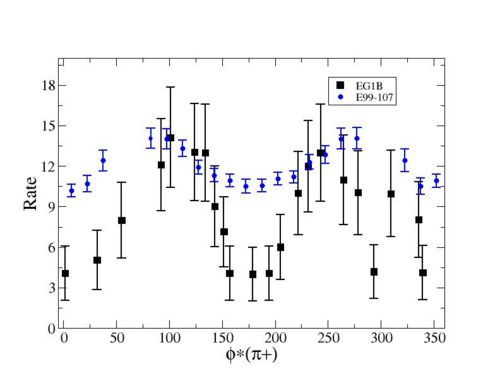
Drift Chamber Feedthroughs
As part of her graduate studies, Tamar Didberidze has been quantifying the performance of two proto-type drift chambers for Hall-B. The ionization chamber principle is similar to the GEM chambers being built for Qweak and was a good training experience for her until the Qweak chambers are completed. Two ionization chamber proto-types were built by JLab and sent to ISU. They are identical except that one uses an all plastic feedthrough to hold the drift chamber wires and another has a plastic feedthrough with a metal tip where the wire makes contact with the feedthrough. The proto-type detectors will be used to evaluate the efficency of the chamber as a function of the ionizating particles position from the end of the wire. A Garfield simulation leads one to believe that the plastic tipped feedthrough will result in a less efficent detector near the end of the wire due to a less radial electric field lines. The answer to this question will impact the design of drift chambers for the CLAS 12 upgrade. During this funding cycle, Tamar has discovered that the proto-type detector using plastic feedthroughs is noisier than the one which has metal tips.
What research and teaching skills and experience has the project helped provide to those who worked on the project
Describe the opportunities for training and development provided by your project.
As part of their graduate studies, Tamar Didberidze and Julian Slamanca, gained skills and experiences in the area of detector development. The design of a charge collector for the Qweak detector exposed them to modern circuit design software as well as some of the compatibility issues between software packages. The construction of ionization chambers using modern machinable plastics like Ertalyte exposed students to conventional machine shop practices and the use of a milling machine. The evaluation of prototype detectors gives students signal processing experience using both analog and digital devices. Both single cosmic events as well as coincidence events using multiple detectors such as scintillators and drift chambers is an on going experiment in our Laboratory for Detector Science. Students are exposed to and gain experience with NIM and VME based signal processing systems. Graduate students also gain teaching experience mentoring the undergraduates that have taken part in the projects described in the Activities section of this report.
What outreach activities have you undertaken to increase public understanding of, and participation in, science and technology?
Describe outreach activities your project has undertaken.
The physics department at ISU travels to local schools to perform physics demonstrations in an effort to increase the public's understanding of science and technology. The demonstrations occur at night in order to illustrate physics principles to students and their parents. I went to Syringa elementary school during this last funding cycle to demonstrate several principles of electricity to student and their parents. A small Van de Graf was used to demonstrate principles of conduction. The principles of producting electricity were demonstrated using solenoids and the effect of liquid nitrogen on Eddy currents induced in a copper conducter were some of the popular components of the demonstrations.
The physics department also holds a mentoring program for high school teachers and their students during the first month of summer. I instructed a group of about 20 teachers and student on the operating principles of drift chambers, scintillators, and solid state detectors. He-3 neutron detectors will be given to the science teachers for use at their home institution. As a result, the neutron detection principle of a He-3 detector was the main focus of the lecture. The He-3 detectors are from a completed experiment at PNNL laboratories and were made available to ISU due to its research partnership with PNNL Laboratories. The arrangement is a fortuitous example of how research and education can combine efforts and improve the public's understanding of science and technology.
Publications and Products
In this section, you will be asked to describe the tangible products coming out of your project. Specifically:
What have you published as a result of this work? Journal publications
Books or other non-periodical, one-time publications
What Web site or other Internet site have you created?
What other specific products (databases, physical collections, educational aids, software, instruments, or the like) have you developed?
What have you published as a result of this work?
This work is in progress and has not resulted in any publications.
Journal publications
- Deeply Virtual Compton Scattering Beam-Spin Asymmetries., F.X. Girod et al. (The CLAS Collaboration), Phys. Rev. Lett. 100, 162002 (2008). http://link.aps.org/abstract/PRL/v100/e162002
- Beam spin asymmetry in deep and exclusive p0 electroproduction., R. De Masi et al. (The CLAS Collaboration), Phys. Rev. C 77, 042201 (2008). http://link.aps.org/abstract/PRC/v77/e042201
- Cross Sections for gamma p to K0*+ Sigma at Egamma=1.7-3.0 GeV , I. Hleiqawi, et. al., Phys. Rev. C 75,2007, 042201.
- Separated Structure Functions for the Exclusive electroproduction of K+ Lambda and K+ Sigma Final States , P. Ambrozewicz, et. al., Phys. Rev. C 75,2007, 045203.
- First measurement of Beam Recoil Observables C(x) and C(z) in hyperon Photoproduction , R. Bradford, et. al., Phys. Rev. C 75,2007, 035205.
Quark-Hadron Duality in Spin Structure Functions g1p and g1d , P. Bosted, et. al., Phys. Rev. C 75,2007, 035203.
Books or other non-periodical, one-time publications
"An Accelerator Based Cargo Container Inspection System for Nuclear Materials", T. A. Forest, et. al., Eight International Topical Meeting on Nuclear Applications and Utilization of Accelerators, American Nuclear Society, pg 470, Aug. 2007
What Web site or other Internet site have you created?
Wiki
What other specific products (databases, physical collections, educational aids, software, instruments, or the like) have you developed?
Contributions
Now we invite you to explain ways in which your work, your findings, and specific products of your project are significant. Describe the unique contributions, major accomplishments, innovations and successes of your project relative to :
the principal discipline(s) of the project;
other disciplines of science or engineering;
the development of human resources;
the physical, institutional, or information resources that form the infrastructure for research and education; and
other aspects of public welfare beyond science and engineering, such as commercial technology, the economy, cost-efficient environmental protection, or solutions to social problems.
